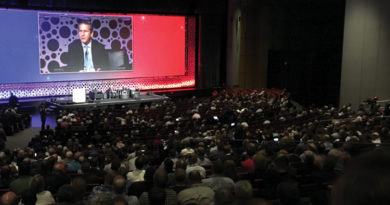Principles for Interoperability in the IoT
By Clarke Stevens
A big problem with the emerging Internet of Things (IoT) is the number of standards and proprietary systems. Apple, Google and Amazon each have proprietary approaches. IoT-related standards are available from IEEE, IETF, W3C, ISO/IEC and virtually every other standards body. Even organizations trying to comply with standards are forced to choose between incompatible options. Integrated Smart Home and other IoT applications and systems cannot achieve their promise if the billions of connected things can connect only with limited subsets of other devices. This article outlines principles for enabling interoperability, scalability and security while including all devices that must be connected.
Systems designed to solve complex problems across reluctantly cooperating competing organizations generally have a few problems that need to be addressed. How can manufacturers make products competitive while satisfying customers’ desire to make products interoperable among competitors? How can customers’ physical security and privacy be protected if private data is being shipped all over the Internet? How can non-technical users hope to sort this out?
Three basic principles can improve the likelihood of success:
- Create an open standard by bringing together all key stakeholders to specify a cooperative solution.
- Create a strict and accurately validated certification process to increase the probability of interoperability.
- Provide a “golden” open-source implementation that gives engineers a head start and simultaneously simplifies interoperability.
A carefully-crafted solution is required to achieve the goal of IoT device interoperability. To reach its potential, the IoT requires a standard that provides a commonly accessible solution to customers across manufacturers, solution providers and different markets. This is the ambition of the OCF, the SDO that has been endorsed by much of the cable industry and over 400 technical companies and organizations worldwide.
In addition to synchronizing the three principles outlined above, the OCF relies on the following architectural ideas:
- Open crowd-sourced data resources:At the core of OCF are data resources — simple data models written in JSON schema that define atomic things like temperature and pressure. These resources are combined into collections that define minimum viable devices. A thermostat device might minimally contain an ambient temperature resource, a desired set temperature resource, and a switch resource to turn on a heating element. More complex devices can be defined by adding more resources. Resources are managed with an open data model crowd-sourcing tool that verifies that contributed models are valid, unique, and meet the criteria of an OCF review board.
- A RESTful architecture:With the basic resources defined in Step 1, all interactions with devices are RESTful and rely on the CRUDN (create, read, update, delete and notify) model, simplifying interaction with controlling clients.
- Built-in security:Security, especially in IoT, cannot be an afterthought. A precise and thoughtful strategy around assuring security of communications and protecting private data is critically important to network operators, who are likely to suffer the brunt of security problems. Cable operators participate in OCF primarily to ensure that they can prevent or quickly recover from security breaches.
- Bridging between existing protocols:OCF doesn’t require other IoT standards to convert, but can be used directly to act as a translator between OCF and other IoT standards. By defining what OCF calls “derived models” (complex mappings between OCF standards) automated tools can generate client, server and bridge code stubs, basic user interfaces, and test scripts for the certification tool. Other SDOs maintain and approve their own resource data models and derived models that supply the mappings. Several SDOs are already working with OCF in this way.
IoT promises to provide unprecedented interoperability that will spawn a new generation of technical solutions to real-world problems. Operators occupy a key position in this ecosystem. The OCF system can help operators work with vendors in numerous industries to provide secure and reliable solutions to consumer, industrial and civic customers for many years to come.

Clarke Stevens
Principal Architect
Shaw Communications
Clarke analyzes emerging technologies and works with senior executives to develop product strategy. Prior to Shaw, Clarke spent over a decade at CableLabs analyzing and developing new technologies. He is a public speaker on the Internet of Things (IoT) and is an active technical contributor to the Open Connectivity Foundation (OCF), an international IoT standards organization. He also served on the board of directors of Universal Plug-n-Play Forum (UPnP), chaired the Technical Committee, and led the Internet of Things task force until UPnP was acquired by OCF.
The complete paper is available to SCTE•ISBE members at:




